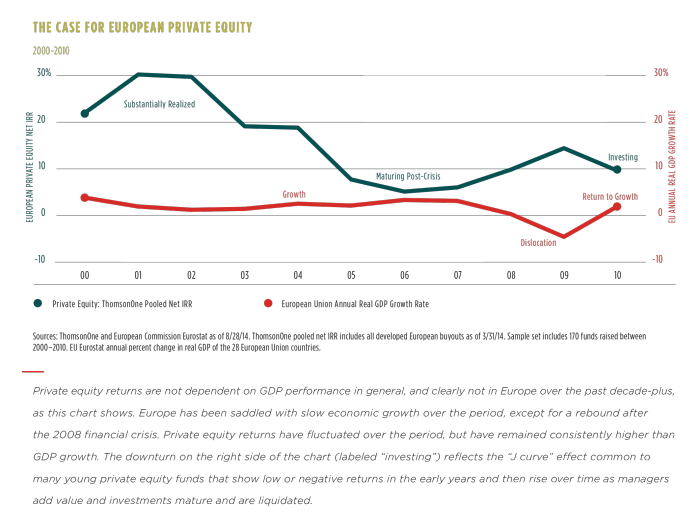What and Why
An article in the previous issue of Insight sought to discern the difference between perception and reality in private equity investing generally, and included a companion article focused on European private equity specifically.
Now, we take a deeper look at international private equity, with an emphasis on Europe as well as Japan and Australia. Once again, there is a perception gap that may lead long-term institutional investors seeking to diversify their portfolio both by asset class/strategy and geography to overlook what we believe are compelling opportunities outside the U.S. Herewith, the what and why of international private equity.
What
What’s the place for an allocation to global private equity as part of a well-diversified portfolio, especially in a period when there is a dearth of positive news out of Europe?
Why
Most important, private equity is a long-term strategy. Today’s commitment will be invested over the next five years and the life of a partnership is a decade or more. Macroeconomic and geopolitical situations will change dramatically over that time frame.
Think back to the early 2000s, for example, when Germany was the “sick man of Europe.” Now, the German economy is strong, and has been for some years. Second, many academic studies have probed the correlation between private equity returns and GDP growth and found that there is actually very little.
Many private companies in Europe are growing much faster than the economies of which they are a part. Third, because European markets are not overheated there are good values available—not only in public markets but in private markets as well. Small and mid-sized privately held companies, in particular, are often attractively priced, making it easier to leave room for value enhancement strategies that, through targeted, disciplined investment, broaden the reach of small companies across their local region and even globally. European companies are active participants in world markets; often, companies realize 80 percent of their revenue outside of the European Union from emerging countries as well as the U.S. and other developed markets.
What
Commonfund Capital believes investors should follow an equally balanced, three-pronged strategy for private equity investing in developed international markets: 1) growth equity; 2) deep value/operational-oriented private equity; and 3) restructurings, turnarounds and distressed situations.
Why
The growth strategy involves investing in growing companies that need capital for expansion and, even more important, professional management to upgrade their business processes. They want to use invested capital in smart ways and work with private equity managers with proven abilities to add value to expand outside of their comfort zone. In the context of Europe—perceived as a low/no growth environment—many of these companies have averaged EBITDA growth of 15 percent annually over the past 15 years. This growth story is what gets buried by the macro headlines coming out of Europe; in the U.K., for example, the government-run healthcare system is one of the top five largest employers in the world, which tends to dampen overall growth rates. But inside the macro story is a micro story of European economies filled with small and mid-sized private companies with attractive growth potential.
Category two branches into two stems: deep value and operational-oriented private equity. Fundamentally, this is about buying good businesses at reasonable valuations—opportunities that may be attributed, in large part, to the inefficiencies found across markets in Europe. One example is a company in Switzerland where the founder and principal shareholder died. Adjusting to the new situation, the family chose to sell the business to a private equity firm that upgraded the management team, focused on enhancing professional management skills and developed a game plan for growing the company. It was a win-win for the family and the company. That story happens over and over again in the deep value/operational private equity category.
The third prong is investing in restructurings, turnarounds and distressed situations. We seek and work closely with private equity managers who specialize in finding distressed companies, negotiating terms with shareholders and creditors, and beginning the complex process of restructuring. Across Europe, the structure of contract terms varies widely, however, as the legal framework in each country is completely different, meaning that legal knowledge doesn’t scale. One can’t be a European restructuring specialist; instead, managers have to specialize somewhere—in the U.K., Germany or France, for example. Given this, the only way to find skilled, experienced managers is to track them down one by one in each country. It’s also important to be out in front. Turnaround/restructuring specialists can quickly accumulate too large a fund and lose their edge. To be successful, it is critical to be capital-efficient, and this gets more difficult as a manager has more assets to invest.
What
Co-investments—in which Commonfund Capital or another investor takes a position alongside a private equity manager—are an attractive strategy not only in the U.S. but also in Europe.
Why
Co-investing typically involves making an additional investment in a company that is already in a private capital manager’s portfolio. The overall objectives are to enhance net returns and to lower costs, which is possible because co-investments are typically charged low to no fees and no carry by the manager. From an investment standpoint, co-investing is really an opportunity to invest more capital in companies in which an investor already has a high conviction level and alongside managers that they know and trust. Access to quality co-investments is a hurdle for many because managers are selective about the partners with whom they co-invest. They want co-investors that are proven, credible and can move quickly and efficiently through the process. Commonfund Capital began making U.S. co-investments in 1997 and international co-investments in 2012.
What
Within the region, Commonfund Capital focuses on northern Europe.
Why
We see the greatest opportunities in northern Europe, including, number one, the U.K., and, number two, the Nordic region. German-speaking countries, including Germany itself as well as Switzerland and Austria, are number three, and number four would be the Benelux countries of Belgium and Luxembourg. Why? First, the greatest number of small and medium-sized companies in Europe reside in those countries. Second, the overall level of economic activity tends to be highest there. Third, there is a strong governance culture in those economies. That doesn’t mean that our entire portfolio is in that region, or there that there aren’t good opportunities elsewhere. In Northern Italy, France and Spain, for example, there are some interesting smaller companies, although, while France is Europe’s second largest economy, it tends to be dominated by large conglomerates.
What
What is the role of allocations to Japan and Australia/New Zealand?
Why
Japan and Australia/New Zealand are very different markets and help to diversify a global private equity portfolio. Differences aside, what they have in common is the framework that one looks for in terms of private equity investing—developed capital markets, investable companies, and a well-structured legal and regulatory culture and tradition. The key in these countries—as elsewhere—is teaming with the type of manager who is able to crack the opportunity set. That’s not always easy because in Japan, for example, the volume of M&A is far behind that of the U.S. and Europe.
Japan is developing a private equity culture—albeit slowly. Until fairly recently, the country was somewhat similar to Germany at one time in the sense that the economy was enormous and, potentially, very active for private equity. But, this type of investing didn’t quite fit the culture. Today, that is changing, especially among sellers who are more pragmatic about realizing value for their asset.
In terms of private equity managers in Japan, selectivity is the key. A lot of that has to do with the availability of cheap debt. Whenever there is cheap debt, a company’s financing options widen and taking on equity investors becomes more problematic—there’s not much incentive when there’s so much debt available. In addition, the expectations for individual company performance and growth are not as dynamic, and pursuing growth private equity style is deemed a bit too aggressive. What that does leave room for are the kind of deep-value situations where one can buy good companies at reasonable prices or step in with a vision for the future in a succession management situation.
When it comes to Australia and New Zealand—which is mostly Australia—a couple of years ago we were more cautious because deals were being chased by a lot of capital. But, that has calmed down now. Local pension funds have faced regulatory constraints and channeled less funds into local private equity funds. Although in the past many private equity transactions were in companies supporting the natural resources industry, there is now an attractive range of investable companies, including those serving the domestic market and a growing number that are exporting to Asia.
Conclusion
Several attributes characterize the countries that Commonfund Capital identifies as the most attractive for private equity investing. As a private equity partnership is a long-term lock-up, the likelihood of achieving a return premium over the public market is a prerequisite. We also seek:
- A body of proven private equity managers with a track record of success investing in local private companies.
- Markets that are large enough to have consistent levels of high-quality management teams to bring experience and professionalism to portfolio companies.
- A developed banking system and adequate liquidity for financing transactions and creating healthy capital markets.
- A consistent rule of law, reliable regulatory standards, accepted accounting practices and transparent reporting.
- We adhere to the premise of “company over country,” believing that attractive small/middle market and growth equity opportunities can be found in all of the developed markets in which we invest.
With respect to Europe specifically, there is a tremendous pool of potentially investable small and middle market companies. According to the European Commission, 99 percent of all European enterprises are small and medium-sized businesses (a small business is defined as less than 50 employees and annual sales of €10 million; medium-sized businesses have less than 250 employees and annual sales of about €50 million). While the environment in Europe has become more complex and, arguably, more volatile, that actually favors on-the-ground investors who are well-connected, possess sector/industry and operational expertise, are steeped in local/regional knowledge, and have a global understanding of best practices so that portfolio companies can improve their competitive position in the marketplace.
Japan and Australia/New Zealand offer the opportunity to diversify geographically into well-established economies with investable companies and a sound legal and accounting framework. The key in these countries is investing with resident private equity managers having experience, a strong network and deep local knowledge.
Academic studies have probed the correlation between private equity returns and GDP growth and found that there is actually very little.



